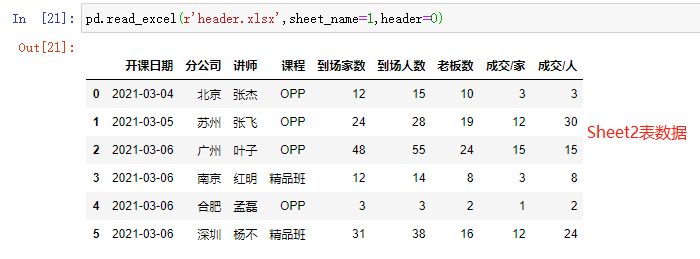【pandas教程】pandas.read_excel()函数header参数详解
阅读(8432)
在现实过程中,excel存储着各种各样的表格数据,每个表的表头(标题)也不一样,有的是一行标题,有的是多行标题,所以利用pandas的read_excel()读取excel表格时,需要通过header参数和index_col参数来指列索引和行索引。
read_excel()函数的header参数决定DataFrame的列索引,可以有以几下种类型:
默认值:0
空类型:None
int类型:header参数为0,也就是第一行作为列索引(理解为表头)
list类型:[0,1] 多行索引MultiIndex
read_excel()函数的index_col参数决定DataFrame的列索引,可以有以几下种类型:
默认值:None。此时程序会给自动给df加一个位置索引(0、1、2、3、4…)
int类型:0、1、2分别对应第一列、二列、三列
list类型:多行索引MultiIndex
下面以下表(表名:header.xlsx)数据来进行read_excel()函数header参数的详细讲解,对应着常见的几中表头:
第一个表(Sheet1)只有数据,没有表头;
第二个表(Sheet2)有一个单行表头;
第三个表(Sheet3)表头上面有一个空行;
第四个表(Sheet4)有一个多行表头;(祥见下图)

1、直接pd.read_excel(r’header.xlsx’),不传任何参数。
#没有传递sheet_name,header参数,默认为第一个表,第一行为列索引,即:sheet_name=0,header=0,行列索引都是从0开始编号。
pd.read_excel(r'header.xlsx')
</code>
<!-- /wp:shortcode --></div>
<!-- /wp:group -->
<!-- wp:image {"id":359,"sizeSlug":"large","linkDestination":"none"} -->
<figure class="wp-block-image size-large"><img src="http://www.dszhp.com/wp-content/uploads/2021/03/read_excel函数header参数01.png" alt="read_excel()函数header参数01" class="wp-image-359"/></figure>
<!-- /wp:image -->
<!-- wp:paragraph -->
<p> 因为没有传递任何参数,默认读取header.xlsx中的第1个表,并以这个表的第一行作为列索引。</p>
<!-- /wp:paragraph --></div>
<!-- /wp:column --></div>
<!-- /wp:columns -->
<!-- wp:paragraph -->
<p>2、传入hedaer=None参数,pd.read_excel(r'header.xlsx',header=None),没有指定列索引,pandas会以数字索引补充。</p>
<!-- /wp:paragraph -->
<!-- wp:shortcode -->
#没有传递sheet_name,默认为第一个表,header=None,pandas自动补充数字索引。
pd.read_excel(r'header.xlsx',header=None)

3、传入sheet_name=1参数,header=0(默认值),pd.read_excel(r'header.xlsx',sheet_name=1,header=0,读取第二个表(Sheet2),以第一行为表头。
#传递sheet_name=1,header=0(默认值),读取第2个表(Sheet2),以第一行为表头。 pd.read_excel(r'header.xlsx',sheet_name=1,header=0)

4、传入sheet_name=2参数,header=1,pd.read_excel(r'header.xlsx',sheet_name=2,header=1),读取第三个表(Sheet3),跳过第一行空行,以第二行为表头。
#传递sheet_name=2,header=1,读取第3个表(Sheet3),跳过第一行空行,以第二行为表头。 pd.read_excel(r'header.xlsx',sheet_name=2,header=0)

5、传入sheet_name=3参数,header=[0,1]一个列表,pd.read_excel(r'header.xlsx',sheet_name=3,header=[0,1]),读取第四个表(Sheet4),以第四个表的1、2行为列索引,[...]中可以为连续的行,也可以为不连续的行,比如[0,3],这时行索引默认为了分公司。
#传递sheet_name=3,header=[0,1],读取第4个表(Sheet4),以第4个表的1-2行为表头。 pd.read_excel(r'header.xlsx',sheet_name=2,header=0)

6、传入sheet_name=2参数,header=1,pd.read_excel(r'header.xlsx',sheet_name=2,header=1,index_col=0),读取第三个表(Sheet3),跳过第一行空行,以第二行为表头,并以开课日期这列为行索引。
#传递sheet_name=1,header=0(默认值),读取第2个表(Sheet2),以第一行为表头,以开课日期为行索引。 pd.read_excel(r'header.xlsx',sheet_name=1,header=0,index_col=0)

pandas读取excel所用的read_excel()函数参数header与index_col的用法是相似的,通过掌握header参数与index_col参数的用法,相信对于大部分不同表结构的excel表都能通过pandas读取,为日常的数据处理带来方便。
#没有传递sheet_name,header参数,默认为第一个表,第一行为列索引,即:sheet_name=0,header=0,行列索引都是从0开始编号。
pd.read_excel(r'header.xlsx')
</code>
<!-- /wp:shortcode --></div>
<!-- /wp:group -->
<!-- wp:image {"id":359,"sizeSlug":"large","linkDestination":"none"} -->
<figure class="wp-block-image size-large"><img src="http://www.dszhp.com/wp-content/uploads/2021/03/read_excel函数header参数01.png" alt="read_excel()函数header参数01" class="wp-image-359"/></figure>
<!-- /wp:image -->
<!-- wp:paragraph -->
<p> 因为没有传递任何参数,默认读取header.xlsx中的第1个表,并以这个表的第一行作为列索引。</p>
<!-- /wp:paragraph --></div>
<!-- /wp:column --></div>
<!-- /wp:columns -->
<!-- wp:paragraph -->
<p>2、传入hedaer=None参数,pd.read_excel(r'header.xlsx',header=None),没有指定列索引,pandas会以数字索引补充。</p>
<!-- /wp:paragraph -->
<!-- wp:shortcode -->
#没有传递sheet_name,默认为第一个表,header=None,pandas自动补充数字索引。
pd.read_excel(r'header.xlsx',header=None)

3、传入sheet_name=1参数,header=0(默认值),pd.read_excel(r'header.xlsx',sheet_name=1,header=0,读取第二个表(Sheet2),以第一行为表头。
#传递sheet_name=1,header=0(默认值),读取第2个表(Sheet2),以第一行为表头。 pd.read_excel(r'header.xlsx',sheet_name=1,header=0)

4、传入sheet_name=2参数,header=1,pd.read_excel(r'header.xlsx',sheet_name=2,header=1),读取第三个表(Sheet3),跳过第一行空行,以第二行为表头。
#传递sheet_name=2,header=1,读取第3个表(Sheet3),跳过第一行空行,以第二行为表头。 pd.read_excel(r'header.xlsx',sheet_name=2,header=0)

5、传入sheet_name=3参数,header=[0,1]一个列表,pd.read_excel(r'header.xlsx',sheet_name=3,header=[0,1]),读取第四个表(Sheet4),以第四个表的1、2行为列索引,[...]中可以为连续的行,也可以为不连续的行,比如[0,3],这时行索引默认为了分公司。
#传递sheet_name=3,header=[0,1],读取第4个表(Sheet4),以第4个表的1-2行为表头。 pd.read_excel(r'header.xlsx',sheet_name=2,header=0)

6、传入sheet_name=2参数,header=1,pd.read_excel(r'header.xlsx',sheet_name=2,header=1,index_col=0),读取第三个表(Sheet3),跳过第一行空行,以第二行为表头,并以开课日期这列为行索引。
#传递sheet_name=1,header=0(默认值),读取第2个表(Sheet2),以第一行为表头,以开课日期为行索引。 pd.read_excel(r'header.xlsx',sheet_name=1,header=0,index_col=0)

pandas读取excel所用的read_excel()函数参数header与index_col的用法是相似的,通过掌握header参数与index_col参数的用法,相信对于大部分不同表结构的excel表都能通过pandas读取,为日常的数据处理带来方便。
#没有传递sheet_name,header参数,默认为第一个表,第一行为列索引,即:sheet_name=0,header=0,行列索引都是从0开始编号。
pd.read_excel(r'header.xlsx')
</code>
<!-- /wp:shortcode --></div>
<!-- /wp:group -->
<!-- wp:image {"id":359,"sizeSlug":"large","linkDestination":"none"} -->
<figure class="wp-block-image size-large"><img src="http://www.dszhp.com/wp-content/uploads/2021/03/read_excel函数header参数01.png" alt="read_excel()函数header参数01" class="wp-image-359"/></figure>
<!-- /wp:image -->
<!-- wp:paragraph -->
<p> 因为没有传递任何参数,默认读取header.xlsx中的第1个表,并以这个表的第一行作为列索引。</p>
<!-- /wp:paragraph --></div>
<!-- /wp:column --></div>
<!-- /wp:columns -->
<!-- wp:paragraph -->
<p>2、传入hedaer=None参数,pd.read_excel(r'header.xlsx',header=None),没有指定列索引,pandas会以数字索引补充。</p>
<!-- /wp:paragraph -->
<!-- wp:shortcode -->
#没有传递sheet_name,默认为第一个表,header=None,pandas自动补充数字索引。
pd.read_excel(r'header.xlsx',header=None)

3、传入sheet_name=1参数,header=0(默认值),pd.read_excel(r'header.xlsx',sheet_name=1,header=0,读取第二个表(Sheet2),以第一行为表头。
#传递sheet_name=1,header=0(默认值),读取第2个表(Sheet2),以第一行为表头。 pd.read_excel(r'header.xlsx',sheet_name=1,header=0)

4、传入sheet_name=2参数,header=1,pd.read_excel(r'header.xlsx',sheet_name=2,header=1),读取第三个表(Sheet3),跳过第一行空行,以第二行为表头。
#传递sheet_name=2,header=1,读取第3个表(Sheet3),跳过第一行空行,以第二行为表头。 pd.read_excel(r'header.xlsx',sheet_name=2,header=0)

5、传入sheet_name=3参数,header=[0,1]一个列表,pd.read_excel(r'header.xlsx',sheet_name=3,header=[0,1]),读取第四个表(Sheet4),以第四个表的1、2行为列索引,[...]中可以为连续的行,也可以为不连续的行,比如[0,3],这时行索引默认为了分公司。
#传递sheet_name=3,header=[0,1],读取第4个表(Sheet4),以第4个表的1-2行为表头。 pd.read_excel(r'header.xlsx',sheet_name=2,header=0)

6、传入sheet_name=2参数,header=1,pd.read_excel(r'header.xlsx',sheet_name=2,header=1,index_col=0),读取第三个表(Sheet3),跳过第一行空行,以第二行为表头,并以开课日期这列为行索引。
#传递sheet_name=1,header=0(默认值),读取第2个表(Sheet2),以第一行为表头,以开课日期为行索引。 pd.read_excel(r'header.xlsx',sheet_name=1,header=0,index_col=0)

pandas读取excel所用的read_excel()函数参数header与index_col的用法是相似的,通过掌握header参数与index_col参数的用法,相信对于大部分不同表结构的excel表都能通过pandas读取,为日常的数据处理带来方便。
由o郭二爷o原创或整理--转载请注明: http://www.dszhp.com/read_excel_header.html

发表回复